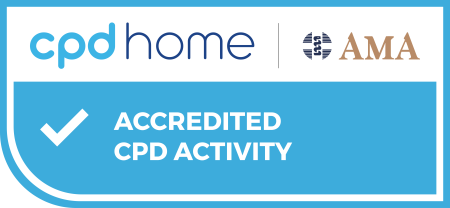Finding accredited CPD
The course on Strokes and Transient Ischaemic Attacks (TIAs) provides a deep dive into the key elements of stroke prevention, diagnosis, treatment, and long-term care. It is designed for medical professionals, particularly in primary care, who play a crucial role in managing cerebrovascular conditions. The course is divided into six detailed units, each covering essential topics:
Unit 1: Introduction and Definitions
This unit introduces the global burden of strokes and TIAs, defining their impact on mortality and morbidity. It provides detailed explanations of stroke and TIA classifications, causes, and the distinction between the two. It covers the latest updates in diagnostic criteria for both ischemic and hemorrhagic strokes.
Unit 2: Clinical Presentation
The second unit explores the varied clinical presentations of stroke, focusing on symptoms based on vascular territory involvement. It also discusses stroke mimics, such as migraines and hypoglycemia, and the importance of accurate differential diagnosis.
Unit 3: Investigation, Acute Management, and Secondary Prevention
This unit covers mandatory and discretionary investigations, including imaging and laboratory tests crucial for stroke diagnosis. It also emphasizes acute stroke management, including the use of antithrombotics and the role of endovascular clot retrieval. Secondary prevention strategies, including lifestyle modifications and pharmacological interventions, are detailed.
Unit 4: Risk Modification and Primary Stroke Prevention
In this section, participants will learn about modifiable risk factors, such as hypertension, diabetes, and obesity, and how to prevent strokes through lifestyle changes. Emphasis is placed on physical activity, diet (particularly the Mediterranean diet), and the importance of managing atrial fibrillation and cholesterol.
Unit 5: Complications in Stroke Survivors
The fifth unit addresses common complications that stroke survivors face, such as depression, sexual dysfunction, fatigue, and driving restrictions. Strategies for managing these complications and improving patient quality of life are discussed, with special focus on post-stroke depression and the importance of early detection.
Unit 6: A Special Note on TIAs
The final unit highlights the urgency of treating TIAs as medical emergencies. It covers the risks of recurrent strokes following a TIA, the ABCD2 risk stratification score, and key management steps, including the use of statins, antithrombotics, and lifestyle changes. Participants will learn the importance of timely intervention to prevent future cerebrovascular events.
This course is ideal for healthcare professionals seeking a structured, evidence-based approach to managing strokes and TIAs, improving patient outcomes, and staying updated with best practices in stroke care.
Cost: $195
Suitable for: All degree qualified medical practitioners.
Study mode: 100% online
Disclaimer: Please note, once you click 'Register now' you will be leaving the AMA’s CPD Home website and entering a third-party education provider’s website. If you choose to register for this learning, you will need to provide some of your personal information directly to the third-party education provider. If you have any queries about how third-party education providers use, disclose or store your personal information you should consult their privacy policy.
Upon completion, your CPD activity record may take up to 4 weeks to be reflected on your CPD Home Dashboard.
You have to log in to see the content of this module.
Provided by
Accredited by

*Medical Board of Australia’s (MBA)’s revised Registration Standard: Continuing professional development (the Standard)